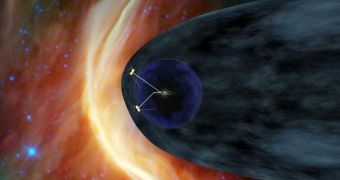Officials with the NASA Jet Propulsion Laboratory, in Pasadena, California, say that they have recently sent a new set of commands to the Voyager 2 space probe, which is currently located on the outskirts of the solar system. The command called on the spacecraft to switch to a backup set of thrusters.
The commands were sent through the NASA Deep Space Network (DSN) on November 4, and officials received confirmation that the probe received and accepted the new lines of code on November 5.
The thrusters affected by this command are the ones that control the roll of the spacecraft. Having the ability to perform this maneuver is absolutely essential to the type of measurements the probe is conducting at the boundary between the solar system and interstellar space.
One of the main reasons why the switch was carried out is because the old probe is moving increasingly farther away from the Sun. As such, it needs to consume as little energy as possible. By switching to previously-unused motors, experts are giving Voyager 2 the ability to do just that.
The older thrusters were beginning to show signs of decay, and increasing fuel inefficiency. However, this was expected to happen, considering that the spacecraft itself is about 34 years old. It is currently heading as far away from our solar system as possible.
JPL experts say that the results of the switch are not yet known. Voyager 2 is scheduled to send back a new transmission on November 13, during which time it will reveal the exact effects that the new commands had on its thrusters, backup system and trajectory.
The transmission will reach our planet on November 14, since the spacecraft is located more than 9 billion miles (14 billion kilometers) away. According to some of its readings, it may have already passed into the heliosheath, and reached the heliopause.
The latter is the place where the pressure the solar wind exerts on the entire solar system is balanced out by the pressure of gas in the interstellar medium. Voyager 2 continues to push forward, as astronomers really want to have accurate readings delivered from outside the solar system.
“Voyager 1 and Voyager 2 are each equipped with six sets, or pairs, of thrusters to control their movement. These include three pairs of primary thrusters and three backup, or redundant, pairs,” a press release from JPL reads.
“The spacecraft's power supply now provides about 270 watts of electricity. By reducing its power usage, the spacecraft can continue to operate for another decade even as its available power continues to decline,” the document adds.
“The thrusters involved in this switch have fired more than 318,000 times. The backup pair has not been used in flight. Voyager 1 changed to the backup for this same component after 353,000 pulses in 2004 and is now using all three sets of its backup thrusters,” the statement concludes.

 14 DAY TRIAL //
14 DAY TRIAL //